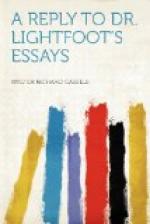Applying similar tests to the Acts of the Apostles we arrived at similar results. Acknowledged to be composed by the same author who produced the third Synoptic, that author’s identity is not thereby made more clear. There is no evidence of the slightest value regarding its character, but, on the other hand, the work itself teems to such an extent with miraculous incidents and supernatural agency that the credibility of the narrative requires an extraordinary amount of attestation to secure for it any serious consideration. When the statements of the author are compared with the emphatic declarations of the Apostle Paul and with authentic accounts of the development of the early Christian Church, it becomes evident that the Acts of the Apostles, as might have been supposed, is a legendary composition of a later day, which cannot be regarded as sober and credible history, and rather discredits than tends to establish the reality of the miracles with which its pages so suspiciously abound.
The remaining books of the New Testament Canon required no separate examination, because, even if genuine, they contain no additional testimony to the reality of Divine Revelation, beyond the implied belief in such doctrines as the Incarnation and Resurrection. It is unquestionable, we suppose, that in some form or other the Apostles believed in these miracles, and the assumption that they did so supersedes the necessity for examining the authenticity of the Catholic Epistles and Apocalypse. In like manner, the recognition as genuine of four Epistles of Paul, which contain his testimony to miracles, renders it superfluous to discuss the authenticity of the other letters attributed to him.
The general belief in miraculous power and its possession by the Church is brought to a practical test in the case of the Apostle Paul. After elaborate consideration of his letters, we came to the unhesitating conclusion that, instead of establishing the reality of miracles, the unconscious testimony of Paul clearly demonstrates the facility with which erroneous inferences convert the most natural phenomena into supernatural occurrences.
As a final test, we carefully examined the whole of the evidence for the cardinal dogmas of Christianity, the Resurrection and Ascension of Jesus. First taking the four Gospels, we found that their accounts of these events are not only full of legendary matter, but even contradict and exclude each other and, so far from establishing the reality of such stupendous miracles, they show that no reliance is to be placed on the statements of the unknown authors. Taking next the testimony of Paul, which is more important as at least authentic and proceeding from an Apostle of whom we know more than of any other of the early missionaries of Christianity, we saw that it was indefinite and utterly insufficient. His so-called “circumstantial account of the testimony upon which the belief in the Resurrection rested” consists merely of vague




